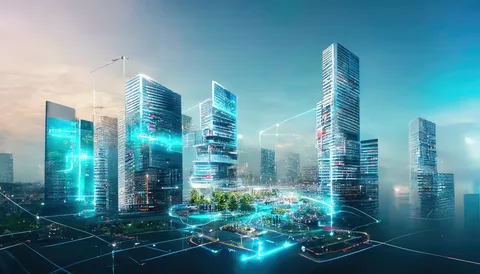
The future of smart cities promises a paradigm shift in urban living, leveraging technology to enhance sustainability, connectivity, and quality of life. This article explores the transformative potential and key components of smart cities worldwide.
1. Introduction to the Future of Smart Cities

The concept of smart cities envisions urban environments equipped with IoT devices, data-driven infrastructure, and sustainable practices. This integration aims to optimize resource use, improve efficiency, and enhance citizen well-being.
2. IoT and Connectivity Infrastructure
IoT technologies form the backbone of smart cities, connecting devices, sensors, and systems for real-time data exchange. Smart grids, smart transportation systems, and connected buildings enable efficient operations and responsive urban management.
3. Sustainable Energy and Environmental Initiatives
Smart cities prioritize sustainable energy solutions like solar power, wind turbines, and energy-efficient buildings. IoT-enabled systems monitor energy consumption, reduce carbon footprints, and promote renewable energy adoption for environmental conservation.
4. Urban Mobility and Transportation Innovations
Smart transportation systems integrate IoT sensors and AI algorithms to optimize traffic flow, reduce congestion, and enhance public transit efficiency. Electric vehicles, ride-sharing platforms, and autonomous vehicles contribute to sustainable urban mobility solutions.
5. Digital Governance and Citizen Engagement
Digital governance platforms enhance transparency, responsiveness, and civic participation in smart cities. Online portals, mobile apps, and data analytics enable residents to access services, provide feedback, and participate in decision-making processes.
6. Smart Infrastructure and Real-Time Data Analytics
Smart infrastructure utilizes real-time data analytics to monitor and manage city assets. Predictive maintenance, waste management optimization, and water conservation initiatives leverage IoT data to ensure infrastructure reliability and sustainability.
7. Public Safety and Smart Security Systems
Smart cities deploy AI-powered surveillance cameras, facial recognition technologies, and predictive analytics to enhance public safety. Integrated emergency response systems and smart street lighting improve security and responsiveness to incidents.
8. Healthcare and Quality of Life Innovations

Healthcare in smart cities benefits from telemedicine, wearable health monitors, and AI-driven diagnostics. Smart homes equipped with remote patient monitoring systems and elder care technologies improve health outcomes and quality of life for residents.
9. Economic Growth and Innovation Hubs
Smart cities foster innovation through tech incubators, co-working spaces, and digital entrepreneurship. Digital connectivity, access to funding, and collaboration with academic institutions spur economic growth and attract skilled talent.
10. Challenges and Future Directions
Despite advancements, challenges like data privacy, digital divide, and infrastructure scalability remain. Future smart city developments focus on AI integration, 5G connectivity, and resilient urban planning to address evolving urban challenges and enhance sustainability.










